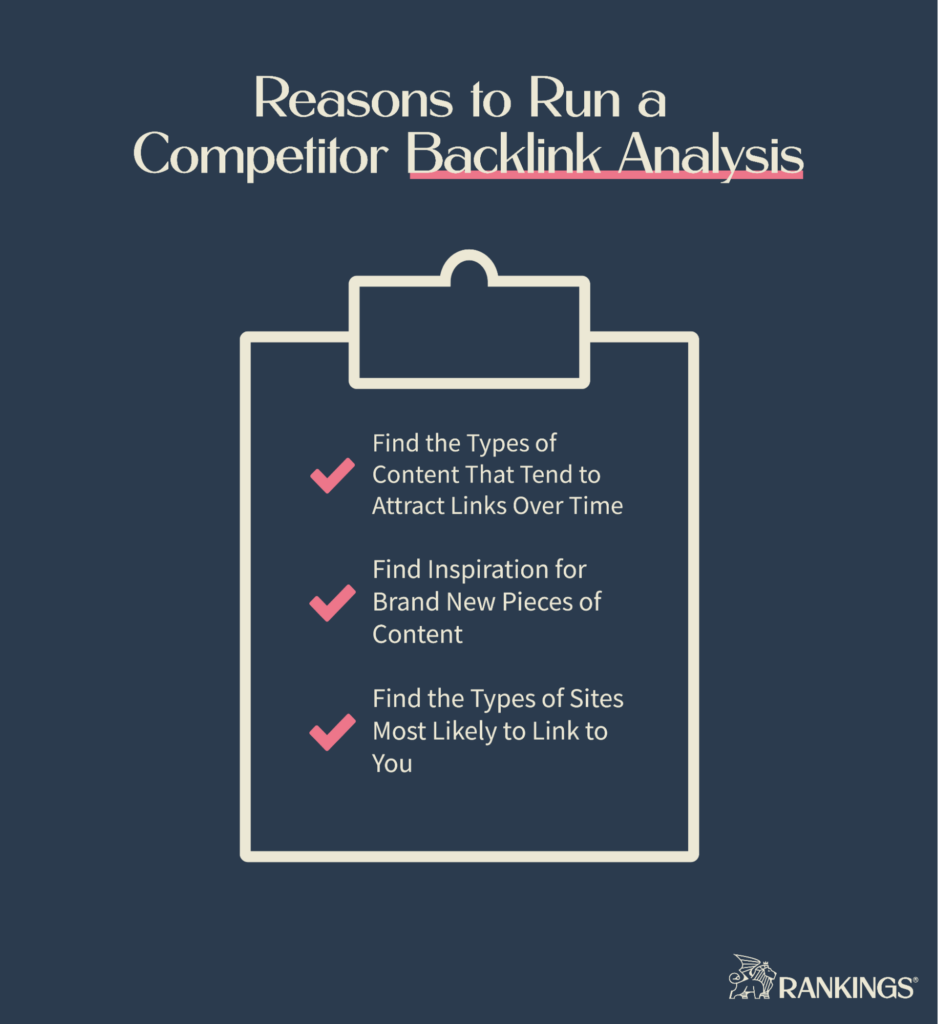Investigating the tactics of successful competitors can help you uncover opportunities for your own law firm.
One way to figure out what’s working for your competitors is by running a competitor backlink analysis. This process involves finding out which pages link to your competitors and what types of content on their sites attract the most links.
Finding that information can give you plenty of direction for your own law firm link building campaigns.
What Is a Competitor Backlink Analysis?
A competitor backlink analysis is a type of audit that looks at the links your competitors have from other websites.
Search engines like Google see backlinks as an indication of a site’s credibility and relevance to a topic or industry.
Understanding what kind of backlinks your competitors have can give you an idea of how credible search engines may find them. It can also give you insights into where some of your competitors’ online visitors come from.
But a backlink analysis doesn’t just look at the number of backlinks competitors have.
These audits also look at the quality and relevance of the sites linking back to competitors. Not every backlink is valuable. A high backlink count on its own doesn’t mean that a site is credible in the eyes of search engines.
For example, backlinks from a coupon website aren’t relevant to a law firm’s website.
Links from other referring domains, such as law blogs, universities, and other related sites, are more relevant.
This type of analysis offers a valuable window into your competitor’s link building tactics. You learn where they get their links, what type of content attracts links, and which sites you may be able to get your own links from.
Why Should Your Law Firm Do a Competitor Backlink Analysis?

Running a competitor backlink analysis can provide you with valuable insights for growing your law firm’s online presence.
The first benefit it provides is guiding you on the types of content that you create.
The results of this analysis will show you what kind of content attracts links over time.
You may be able to earn similar backlinks for your own firm by creating similar content. Referring websites may be willing to link to you instead of competitors if what you create is better than what was already out there on a given topic.
For example, you may discover that your competitor has an article about a statute that is out of date but has a ton of backlinks.
You might create an updated article and reach out to the referring websites to ask them to link to you instead.
A backlink analysis can also serve as a wellspring of ideas for new content.
Your analysis could show that a competitor has high-quality links pointing to a study they did on average accident settlement amounts. Looking at that study could inspire you to gather your own data on a related topic, like settlement timelines. You could then reach out to other sites asking them to link to your new linkable asset.
Your analysis will also surface new link building opportunities for your site.
At the end of the process, you’ll have a list of relevant websites that trust your competitors enough to link back to them. Sites that link to your competitors may also be willing to link to you.
Two Different Approaches to Competitor Backlink Analysis
There are 2 different approaches you can take when you do a competitor backlink analysis:
The first is a targeted, keyword-based approach that looks at the number of links you need to rank for a target term. This approach is best if you have a specific page that you want to rank for a topic.
The second is a broad, domain-based approach that looks at the kinds of content your competitors have which attract the most links. The broad approach is better if you want to know what type of content you can create to attract links.
The one you choose depends on the goals of your SEO campaign.
You can use the same tool for either type of analysis, though.
You’ll need a tool that collects backlink data as well as other SEO metrics like organic traffic and keyword rankings for a variety of websites. We recommend using Ahrefs to get this data. It’s an industry-standard SEO tool with all of the features you need to complete a backlink analysis.
How to Take the Targeted Approach
The targeted approach is an efficient way to determine how many backlinks you need to rank on Google for a keyword.
An example of a good time to use this approach would be if you had a blog post about car accidents that’s stuck on the second page of Google. You could look at the number and quality of links that top competitors for the main keyword have to their pages. This can tell you how many you should plan to build if you want to rank too.
The steps below will guide you through running a keyword-based analysis of your competitors’ backlinks.
1. Find Competitors for Your Target Keyword
All you need to get started is a target keyword and access to Ahrefs.
Go to Ahrefs Keywords Explorer and enter your target keyword to find out which sites rank for it. Then you’ll need to decide which sites are your actual competitors and which are irrelevant. The walkthrough below will guide you through the process.
In the example above, only other law firm websites are relevant competitors to an attorney who wants to rank for the keyword car accident lawyer.
Looking at irrelevant competitors like Forbes or Nolo.com could end up skewing the estimated number of backlinks you need into something unreachable.
Now that you know who your competitors are, you’re ready to start looking at their backlink profiles.
2. Filtering the Backlinks Report
Ahrefs can show you all of the backlinks pointing to each of your competitor’s pages. But not all of those backlinks will be relevant or valuable. You’ll need to filter the list down to get to the real insights.
Use the walkthrough below to see how you can access and filter the backlinks report for your competitor’s pages.
Repeat this process for each of the competitors that you found. You can save yourself some time by opening each competitor’s backlinks report in a new browser tab.
Applying these filters allows you to see only the most impactful backlinks.
A backlink from a website with a low domain rating (DR) or with less than 1000 visitors per month isn’t likely to be something that moves the needle. The same goes for a backlink that isn’t in the referring page’s body copy.
3. Analyzing the Backlinks Reports
Now that you’ve had a look at the types of pages that are pointing to competitors, you’re ready to reverse engineer the kind and number of backlinks you’ll need.
First, calculate the average DR of the referring domains to get a sense of what type of websites you’ll need links from.
Then calculate the average number of backlinks each competitor page has.
For example, you might discover that your competitors have 10 backlinks on average from sites with an average DR of 50. You would need to get the same amount to catch up with them.
But domain rating is on a logarithmic scale.
That means you don’t necessarily need 10 backlinks from DR 50 websites.
You could get 5 links from DR 60 websites instead. Or 2-3 from DR 70 websites. You could get fewer links from higher-quality websites and still outpace your competitors.
With this knowledge, you’re ready to start reaching out to those DR 50+ websites with link building pitches.
How to Take the Broad Approach
The broad approach takes a different tack.
The goal here isn’t to figure out how many links you’ll need for your content. Instead, this method shows you what kinds of content you can create to attract new links over time. You can also use it to learn what sites link to sites that are the most like yours.
The steps below will guide you through running a keyword-based analysis of your competitors’ backlinks.
1. Find Your Competitors by Similarity
Your competitors on Google are almost never the law firms in your city. The sites that you compete with for backlinks and positions on Google may be firms you’ve never heard of before.
Without a little research, your backlink analysis may miss out on important competitors.
You can use Ahrefs’ Organic Competitor report to help you find the pages that are most similar to your own. Here’s how:
When you know who your competitors are, you’re ready to start looking at the content that attracts the most backlinks to their sites.
2. Find Your Competitor’s Backlinks
After you find your top competitors, you’re ready to start inspecting their backlink profiles.
This step is going to require heavy filtering for you to get actionable insights. Ahrefs will show you every inbound link it can find for each competitor. That could be hundreds of thousands of links for some domains.
Follow the walkthrough below to see how to inspect and filter each competitor’s backlink profile.
Note that the Organic competitors report may list some sites that aren’t exact analogs of yours.
For example, a report for lawyers might have legal directories in the list. Those aren’t relevant when you run a backlinks analysis. If you want an accurate picture of the content you should make, limit the competitors you inspect to other lawyer sites.
Repeat this process for each of your competitors.
3. Determine the Types of Content to Create
Now you’re ready to start surveying the types of content on competitors’ sites that attract the most links.
The goal in this step is simple. Find the pages on your competitor’s sites that have attracted links. Then consider whether it makes sense for you to make a similar—but better—page.
The walkthrough below will give you an idea of how this process works.
You may be tempted to export each competitor’s report and place it in a spreadsheet so you can take notes on what’s working for them. Or you may just want to jot down notes and ideas as you look at what your competitors have.
There’s just one thing you must check before you start creating new content like your competitors: link velocity.
Some pages attract links all at once. Then the number of links it accumulates over time starts to dwindle.
This can happen because the page covers something that’s timely or newsworthy. It will almost never be worth emulating by the time you find it.
Look for pages that steadily acquire links over time.
Pages that continue to gain new links month after month are the best topics to cover for your link building campaign.
Here’s how you can identify these types of topics:
And that’s it. Once you’ve noted down some topics that interest you, you’re ready to start creating content and building links.
What to Do After Analyzing Backlinks
Analyzing your competitors’ backlink profiles may be the end of this particular process, but it’s just the beginning of building new links to your website.
Once you’ve seen what’s working for others, you’re ready to start planning your next steps.
Create Content to Attract Links
The backlink analysis shows you who’s linking to your competitors and what they like to link to. That information should give you an idea of what might work for you.
Looking at what attracts links to your competitors can help you create a few different types of content.
In the first category, you have content that could replace what your competitors have. You might find that your competitors have an article that’s out of date or inaccurate. This is a golden opportunity for you to create something better and get referring domains to link to you instead.
In the second category, you have the types of content that naturally attract links.
Linkable assets include things like detailed guides, data studies, original research, or unique thought leadership. It takes time to create this kind of content, but great content of this type is easier to pitch to referring domains.
Link Building Outreach
You didn’t spend all this time finding out which sites link to your competitors just for fun.
Now it’s time for you to plan how you’ll reach out to these referring domains.
Some referring domains may accept guest posts. You might reach out to the site owner to ask if they’re interested in letting you write a post for their blog. These sites may let you link back to a relevant page on your own website.
You can also reach out to the referring domains you found in your competitor backlink analysis.
If you’ve created something that improves upon or updates a flaw in a competitor’s page, get in touch with the referring domain’s webmaster. They may be willing to replace the backlink with one that points to your site instead.
The same goes for linkable assets. You can reach out to webmasters, editorial teams, and site owners to ask for a link if you think the content you made fits in with what they tend to publish.
Final Thoughts: Linking Everything Together
A competitor backlink analysis is a powerful tool for figuring out what’s working for competitors that will translate to your own site.
It can help you figure out what type of content tends to get links. It’s great for finding the sites that like to link to sites just like yours. It can even inspire you to create new content.
But a backlink analysis is just one tool for starting an attorney’s link building campaign.
Creating new linkable content and reaching out to website owners is unfamiliar territory for most lawyers. And even doing the backlink analysis can be an uphill battle. The best choice for most law firms is to work with a law firm SEO expert to get real results.
At Rankings.io, we help elite personal injury firms get more high-value cases through search engine optimization. If you want to increase your backlinks, create great content, and bring in more leads, contact us today.
The post How to Run a Competitor Backlink Analysis: Two Different Approaches + Interactive Guides appeared first on Rankings.



